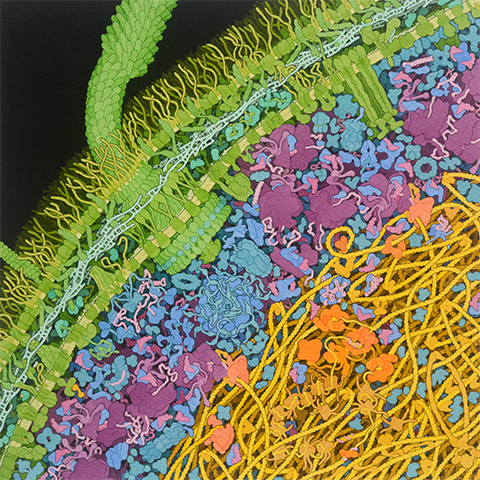How bacteria fight back against promising antimicrobial peptide
Antimicrobial peptides have potential in antibiotic drug development, including possible uses in combination with other antibiotics for infections that are difficult to treat. Scientists have shown that the peptide TAT-RasGAP317-326, originally developed as an anticancer compound, inhibits E. coli and Staphylococcus aureus, among other bacteria. The peptide contains residues 317-326 of the Ras GTPase-activating protein, or RasGAP, with an attached N-terminal cell-penetrating sequence from the HIV transactivator of transcription, or TAT, protein, and will be called TAT-RasGAP in this article for simplicity. Maria Georgieva at the University of Lausanne Hospital Center and a team in Switzerland performed a resistance selection experiment over 20 passages to obtain an E. coli strain resistant to TAT-RasGAP to identify mutations that could elucidate this peptide’s mechanism of action. In a recent Journal of Biological Chemistry article, they showed that a mutation in BamA, an outer membrane protein critical for the insertion of other membrane proteins, helped block the peptide’s antimicrobial activity.

The authors traced the mutation that protects E. coli from TAT-RasGAP to a negatively charged loop in BamA that extends into the extracellular space. The mutation changes a residue from a negative to a neutral charge. The authors hypothesized that the positively charged TAT-RasGAP may interact with this negatively charged loop for cell entry, and a negative-to-neutral mutation could have developed in the resistant strain to block this electrostatic interaction. Modeling and molecular dynamics indicated that BamA’s negatively charged loop likely interacts with the peptide.
However, further experiments showed that TAT-RasGAP does not produce the same changes as known BamA inhibitors based on bacterial morphology viewed by brightfield microscopy and outer membrane protein quantification, indicating that BamA is unlikely inhibited by TAT-RasGAP. Future experiments will help resolve the full mechanism of action for TAT-RasGAP and could lead to novel antibiotics.
Enjoy reading ASBMB Today?
Become a member to receive the print edition four times a year and the digital edition monthly.
Learn moreGet the latest from ASBMB Today
Enter your email address, and we’ll send you a weekly email with recent articles, interviews and more.
Latest in Science
Science highlights or most popular articles

Mapping fentanyl’s cellular footprint
Using a new imaging method, researchers at State University of New York at Buffalo traced fentanyl’s effects inside brain immune cells, revealing how the drug alters lipid droplets, pointing to new paths for addiction diagnostics.

Designing life’s building blocks with AI
Tanja Kortemme, a professor at the University of California, San Francisco, will discuss her research using computational biology to engineer proteins at the 2026 ASBMB Annual Meeting.

Cholesterol as a novel biomarker for Fragile X syndrome
Researchers in Quebec identified lower levels of a brain cholesterol metabolite, 24-hydroxycholesterol, in patients with fragile X syndrome, a finding that could provide a simple blood-based biomarker for understanding and managing the condition.

How lipid metabolism shapes sperm development
Researchers at Hokkaido University identify the enzyme behind a key lipid in sperm development. The findings reveal how seminolipids shape sperm formation and may inform future diagnostics and treatments for male infertility.

Mass spec method captures proteins in native membranes
Yale scientists developed a mass spec protocol that keeps proteins in their native environment, detects intact protein complexes and tracks drug binding, offering a clearer view of membrane biology.

Laser-assisted cryoEM method preserves protein structure
University of Wisconsin–Madison researchers devised a method that prevents protein compaction during cryoEM prep, restoring natural structure for mass spec studies. The approach could expand high-resolution imaging to more complex protein systems.

